
The rose is rightly called the queen of flowers. With the right neighbors, their attractiveness can be increased even more. These 22 plants are suitable for underplanting roses.
In a nutshell
- Combine plants with similar requirements
- should emphasize roses visually
- they must not dominate
- always plant at a distance
Table of contents
- Perennials as underplanting
- ornamental foliage plants
- ornamental grasses
- Aromatic herbs
- frequently asked Questions
Perennials as underplanting
Blue Pillow 'Blue Tit' (Aubrieta x cultorum)
Even before the first rose blossoms open, the blue cushion provides great splashes of color in the bed.
- Growth: carpet-like, compact, 8 to 10 cm
- Flowering time: April to May
- Flowers: simple, grape-shaped, blue-violet
- Foliage: grey-green, finely hairy, notched margin
- Location: sunny, fresh, permeable, rich in rocks
Primroses (Primula)
primrose varieties have their big appearance when roses have just been ridden down and are not yet very impressive.

- Growth: herbaceous, carpet-forming, up to 30 cm
- Flowering time: March to May
- Flower: single, white, yellow, pink, red, violet, multicolored, striped or edged
- Foliage: basal rosette, oval to oblong
- Location: Sunny in spring, semi-shady in summer, rich in nutrients
Tip: Garden primroses are particularly suitable for underplanting small to medium-sized roses.
Horned violet (Viola cornuta)
With a huge selection of varieties, flower sizes, colors and color compositions, these neighbors roses offer variety in the bed for many weeks.

- Growth: bushy, annual or biennial, 15-20 cm
- Flowering period: March-October
- Flower: multicolored, slightly curved spur at the bottom of the flower
- Foliage: green, ovate
- Location: sunny to semi-shady, fresh soil
Tip: When it comes to horned violets, you should look out for real varieties such as 'Alba Minor', 'Bowle's Black' or 'Roem von Aalsmeer'. They go well with bedding, shrub and old roses.
Catnip (Nepeta)
It is an intensely fragrant rose companion and suitable for planting under all classes of roses.

- Growth: loosely bushy to prostrate, 30 to 40 cm
- Flowering period: May to August, beautiful second bloom
- Flower: simple, lip-shaped, violet-blue
- Foliage: oval to cordate, notched margin
- Location: sunny, dry to fresh, humic, mineral
Pillow Aster 'Blue Lagoon' (Aster dumosus)
It only presents its full splendor late in the year, but then with full force. To bloom so profusely every year, these neighbors need to be divided every two to four years.
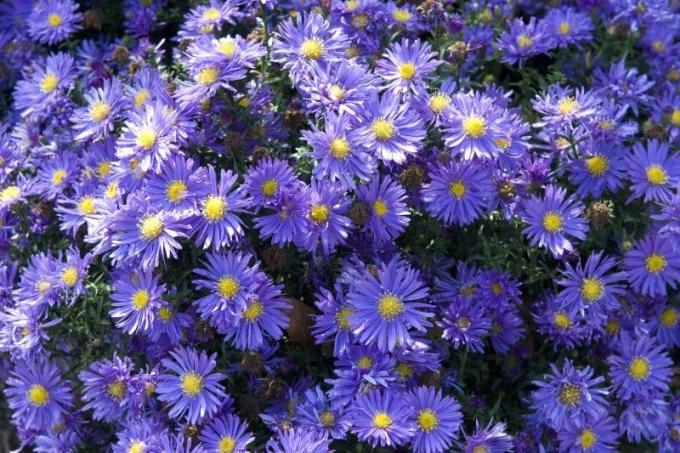
- Growth: pillow-like, hemispherical, 40 to 50 cm
- Flowering time: September to October
- Flower: dark violet with a yellow centre, semi-double
- Foliage: green, lanceolate, entire, smooth
- Location: sunny, humic, nutritious, fresh, well-drained
creeping spindle (Euonymus fortunei)
This robust and easy-care ground cover is particularly recommended for underplanting shrubs and climbing roses.

- Growth: dense, bushy, approx. 30 cm
- Flowering period: June/July
- Flower: whitish-green, inconspicuous
- Foliage: green with white or yellow accents, pretty fall color
- Location: sunny to semi-shady, moderately dry to moist
Whitsun Violet 'Albiflora' (Viola sororia)
Whether in combination with bed roses or alone, the adaptable, robust Whitsun violet is always an eye-catcher.
- Growth: cushion-like, forming rhizomes, 10 to 15 cm
- Flowering period: May to June
- Flower: simple, white, cupped
- Foliage: cordate, serrate, rough
- Location: sunny to semi-shady, fresh, well-drained, humic
Cushion bellflower (Campanula portenschlagiana)
This profusely flowering and long-lived perennial can flower again by pruning after flowering.
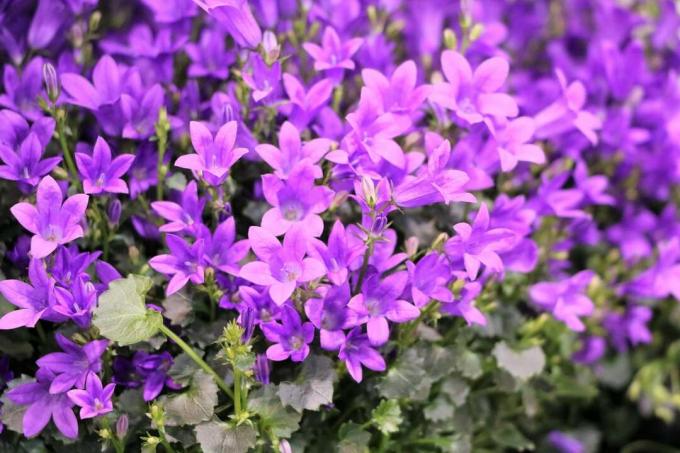
- Growth: cushion-like, runner-forming, 8 to 15 cm
- Flowering period: June to August
- Flower: violet, simple, bell-shaped
- Foliage: rounded, glossy, leaf margin sinuate
- Location: sunny to semi-shady, well-drained, dry to fresh
'Kobold' (Liatris spicata)
With its bright, fluffy flowers, this undemanding perennial lives up to its name.
- Growth: compact, upright stems, 20 to 40 cm
- Flowering period: July to September
- Flowers: violet-pink flower spikes
- Foliage: dark green, narrow, entire
- Location: sunny, nutritious, slightly dry to fresh
Candytuft (Iberis sempervirens)
This evergreen beauty also impresses with its immense luminosity and good winter hardiness.

- Growth: hemispherical, cushion-like, woody, 15 to 30 cm
- Flowering time: April to May
- Flowers: simple, white cymes
- Foliage: evergreen, lanceolate, entire, leathery
- Location: sunny, well drained, dry to fresh
Cranesbill 'Berggarten' (Geranium x cantabrigiense)
Because of its stature, height and variety of flower colors, the cranesbill is the ideal companion for roses.
- Growth: carpet-forming, ground-covering, approx. 25 cm
- Flowering period: May to July
- Flower: simple, cupped, white, pink, blue or lilac
- Foliage: green, rounded, lobed margin, aromatic fragrance
- Location: sunny to semi-shady, nutritious, moderately moist
Carpet Aster 'Snow Flurry' (Aster pansus)
With its small white flowers, it covers the rose like a blanket of snow, enhancing its luminosity.
- Growth: creeping, covering the ground, 15 to 20 cm
- Flowering time: September to October
- Flowers: simple, white, in panicles
- Foliage: green, linear, densely hairy underneath
- Location: Sun to semi-shade, dry to fresh
ornamental foliage plants
Lady's Mantle (Alchemilla)
With it, the often bare base of rose bushes can be concealed very well. However, it should not be planted too close to the rose.

- Growth: herbaceous, low, 5 to 50 cm
- Flowering period: May to August
- Flowers: delicate yellow, umbel-like
- Foliage: rounded, calyx-like lobed, velvety glossy
- Location: sunny and semi-shady, well-drained soil
Tip: In the morning hours, the lady's mantle offers a special spectacle when the dewdrops collect on the leaves.
Mini hostas (hostas)
Hostas as neighbors do not tolerate direct sun, but are shaded by the rose when planted under.

- Growth: persistent, herbaceous, 10 to 25 cm
- Flowering period: June to September
- Flower: white or violet, bell-shaped on long stems
- Foliage: Heart-shaped, green, white, bluish, lightly variegated
- Location: semi-shady to shady
Tip: The more light parts of the leaves, the more sun is tolerated.
Purple Bells (Heuchera)
This plant is less noticeable for its flowers than for its numerous leaf shapes and colors.

- Growth: dense clumps, 15 to 70 cm depending on the variety
- Flowering period: June to July/August
- Flower: small, bell-shaped, red, pink or white, strongly branched flower stalks
- Foliage: semi-evergreen or evergreen
- Location: sunny to semi-shady depending on leaf color, fresh soil
ornamental grasses
Pennisetum alopecuroides (Pennisetum alopecuroides)
Whether for planting underneath or standing alone, this dainty grass is always a visual highlight.
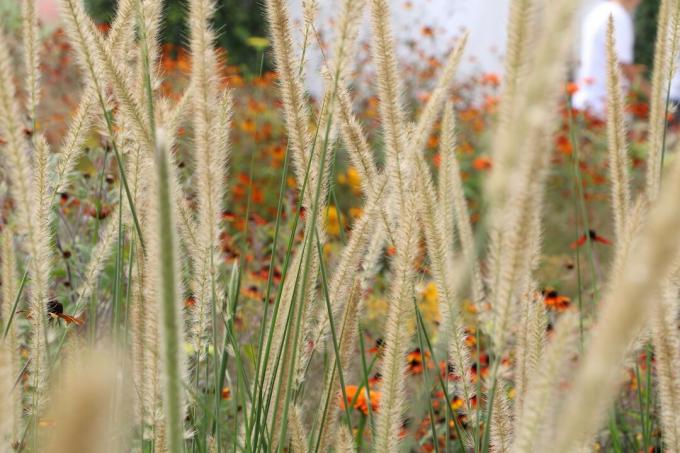
- Growth: bushy, hemispherical, sweeping, 40 to 60 cm
- Flowering period: August to September
- Flowers: downy hairy flower spikes, reddish brown to silvery white
- Foliage: grey-green, narrow, golden yellow in autumn
- Location: sunny, slightly dry to fresh, nutritious
Purple Love Grass (Eragrostis spectabilis)
Grasses such as purple love grass are also good neighbors for roses, especially hybrid tea roses.

- Growth: arching, spreading, 40 to 60 cm
- Flowering period: August to October
- Flowers: simple, in panicles, violet-purple
- Foliage: smooth, entire, strap-like
- Location: sunny, dry to fresh, neutral
Red feather bristlegrass (Pennisetum setaceum rubrum)
With its growth and the color of its leaves, this grass is an attractive companion for roses.

- Habit: grassy, clumpy, overhanging, 40 to 60 cm
- Flowering period: July to September
- Flowers: reddish-grey to dark red, like panicles
- Foliage: long, narrow, lanceolate
- Location: sheltered, sunny, normal garden soil
Aromatic herbs
Calamints (Calamintha)
Small-flowered calamints are prized as neighbors for roses, among other things because of their health and robustness.
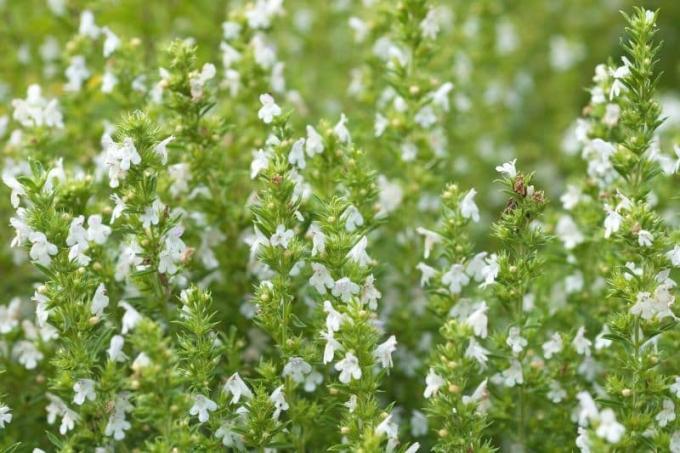
- Growth: bushy, clump-forming, 30 to 40 cm
- Flowering period: July to September
- Flowers: grape-shaped, white, tinged with light violet, fragrant
- Foliage: small, oval, serrate leaf margin, fragrant
- Location: sunny, dry, permeable
Curry herb (Helichrysum italicum)
The high-contrast, silvery leaves of the curry herb are particularly suitable for planting under pure white or creamy white roses.

- Growth: clumpy, bushy, semi-shrub
- Flowering period: June to July
- Flowers: simple, yellow, umbel-shaped, fragrant
- Foliage: silvery, needle-like, typical curry scent
- Location: sunny, sheltered from the wind, rather dry
Oregano 'Rose Dome' (Origanum vulgare)
Like many herbs, oregano can help in repelling pests and so not only act as a pretty accessory for roses.
- Growth: bushy, clump-forming, 20 to 40 cm
- Flowering time: August/September
- Flowers: like panicles, pink-pink
- Foliage: oval, prickly
- Location: sunny, permeable, neutral
Woodland Sage (Salvia nemorosa)
Roses harmonize particularly well with the blossoms of herbs. For example, purple blooming sage a real eye-catcher for underplanting pink roses.
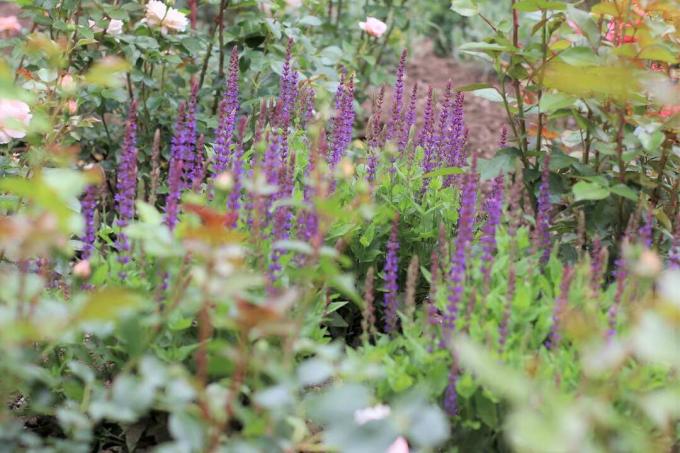
- Growth: bushy, upright, 30 to 60 cm
- Flowering period: June to August
- Flowers: spike-shaped, lip-shaped, whorls, white, pink, violet, blue
- Foliage: lanceolate, toothed, fragrant
- Location: sunny, moderately dry to fresh, tolerant of lime
frequently asked Questions
In the right combination, they should visually emphasize the shape, flower and leaf color of the rose. They should have similar location requirements and not compete with each other. With annual companion plants, new color combinations and styles can be tested every year. With perennials you only have to do this once and can enjoy the next few years.
Lavender is considered a classic among rose companions, although both have completely different requirements. If you still don't want to do without it, you should only plant it at a sufficient distance from roses, not as an underplanting. In this way, the different requirements can be better met.
Roses are deep-rooted and can draw water from deep layers of soil when it is dry. Varieties with small leaves are particularly heat-tolerant, as they do not offer the sun such a large surface to attack.


